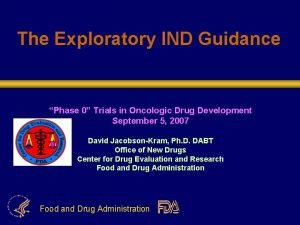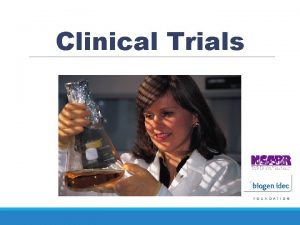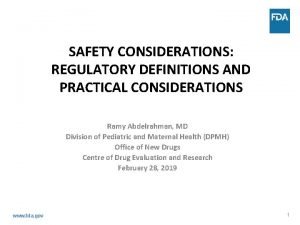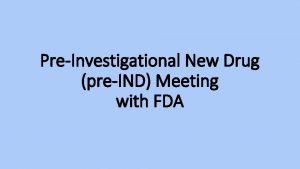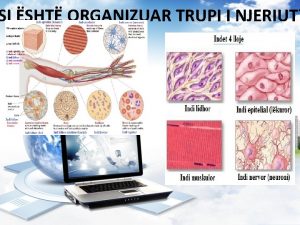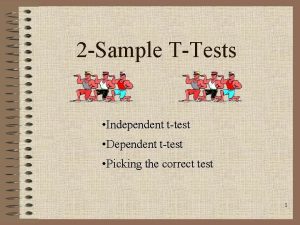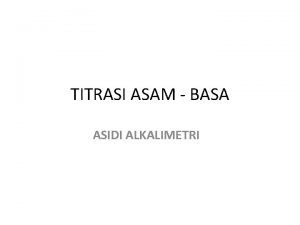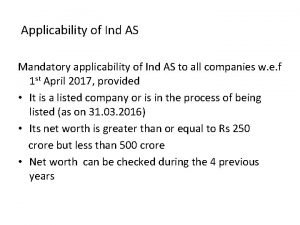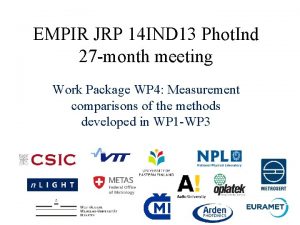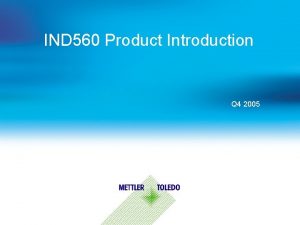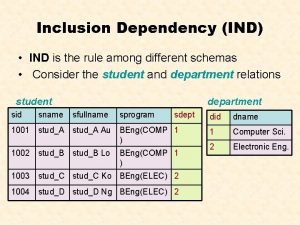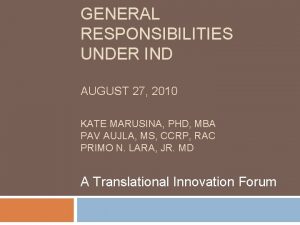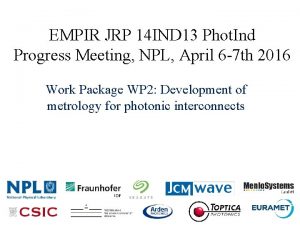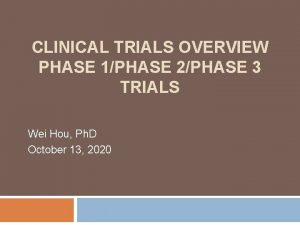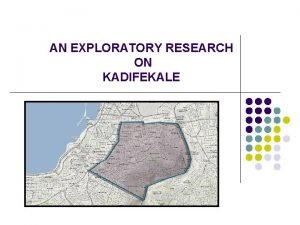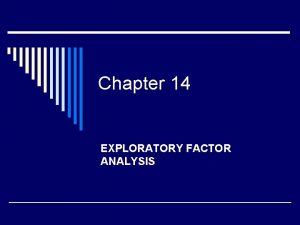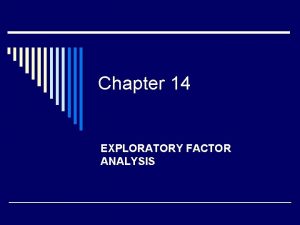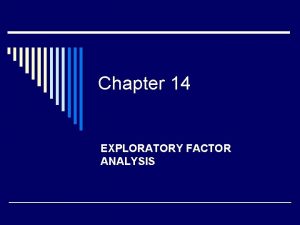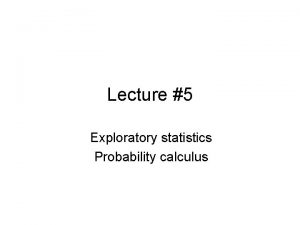The Exploratory IND Guidance Phase 0 Trials in






























- Slides: 30

The Exploratory IND Guidance “Phase 0” Trials in Oncologic Drug Development September 5, 2007 David Jacobson-Kram, Ph. D. DABT Office of New Drugs Center for Drug Evaluation and Research Food and Drug Administration

Challenges in Improving Efficiency of Drug Development Ø NME development = high risk and cost u Extremely high failure rate before IND u NME IND = NDA <20% of time u Reported >50% failure rate in Phase 3 u Decreased NME NDAs despite increased INDs u Cost per NME approved estimated at >$800 M Food and Drug Administration

Number Approved Number Filed As of 31 -Aug-06 *Includes therapeutic biologic products transferred from CBER to CDER effective 10/1/2003. Food and Drug Administration

Exploratory INDs: Guidance to Industry, Investigators and Reviewers Ø Draft guidance published April 2005, over 350 comments to the docket. Final published in January 2006. Ø “For the purposes of this guidance the phrase exploratory IND is intended to describe a clinical trial that occurs very early in phase 1, involves very limited human exposure (up to 7 days of dosing) and has no therapeutic intent. Ø Existing regulations allow flexibility of the amount of data that need to be submitted with an IND—depending on the goals of the investigation, the testing being proposed the expected risks. Ø Viewed as pavestone on the critical path. Food and Drug Administration

Use of exploratory INDs (Exp. INDs) in improving efficiency of drug development Ø Exp. INDs allow sponsors to evaluate up to five chemical entities or formulations simultaneously. Ø When a lead compound has been selected, the Exp. IND is closed and drug development proceeds along the traditional pathway. Ø Exp. INDs provide opportunity to study PK and target interaction early in drug development. Food and Drug Administration

Goals of exp. INDs Ø Gain an understanding of the relationship between a specific mechanism of action and the treatment of a disease. Ø Provide information on PK Ø Select the most promising lead product from a group of candidates designed to interact with a particular therapeutic target. Ø Explore a product’s biodistribution characteristics using various imaging technologies. Food and Drug Administration

Types of studies: microdose Ø Microdose studies are designed to evaluate pharmacokinetics or imaging of specific targets and are designed not to induce pharmacological effects. Ø A microdose is defined as less than 1/100 th of the dose calculated to yield a pharmacological effect and ≤ 100 micrograms. Food and Drug Administration

Microdose studies Ø Ø Potential risks to subjects very limited Enabling study: u Single mammalian species u Clinical route of administration u Single dose, 14 -day observation u Routine endpoints: n Clinical observations n Body weights n Hematology and clinical chemistries n Histopathology Identification of minimally toxic dose or demonstration of large margin of safety (e. g. 100 X) Genetox not necessary. Food and Drug Administration

Position Paper on Non-clinical Safety Studies to Support Clinical Trials with a Single Microdose EMEA, June 2004 Enabling preclinical safety studies: Ø General toxicology studies using two routes of administration, IV plus clinical route Ø In vitro genotoxicity studies performed according to ICH guidance Ø EMEA requires more data: two routes of administration and genetox studies Ø Food and Drug Administration

Types of studies: Clinical Trials Designed to have Pharmacological Effects Ø Ø Ø Paradigm first proposed by Ph. RMA in May of 2004 Up to 5 compounds with a common biological target, not necessarily structurally related Up to 7 repeated doses in clinic in healthy subjects or minimally ill patients Goal is to achieve a pharmacological response but not an MTD Ph. RMA collected a data base on 106 drugs tested in two species and in phase 1 clinical trial to support preclinical safety paradigm Food and Drug Administration

Safety Requirements for Exploratory IND designed to produce pharmacological effects Ø Ø 14 -day repeated dose tox study in rodent, full clinical and histopathology Safety pharmacology (cv, cns, resp) as in ICH S 7 A Bacterial mutation assay and micronucleus from 14 -day study Repeated dose study in second species (dog) at rat NOAEL. Administrations equivalent to number of dosing days in clinical trial Food and Drug Administration

Clinical starting and stopping doses Ø Ø Start dose would be 1/50 the rat NOAEL (mg/m 2). If dog shows toxicity at rat NOAEL, compound not included in exploratory IND Stopping dose would be whichever is lowest: Dose that induces pharmacological effect or target modulation u ¼ of rat NOAEL u Dose giving ½ of AUC in rat 14 day study or dog AUC if lower than rat u Food and Drug Administration

Evaluation of Pharma Dataset* Ø Ø Would starting clinical trials at a dose equivalent on a body surface area basis to 1/50 the NOAEL dose in rodents be safe? Conclusion: Based on evaluation of 106 compounds, all trials would have been conducted safely under the exp. IND paradigm Would it be safe to stop trials on the basis of criteria detailed in the guidance (i. e. dose, exposure, clinical effects)? Conclusion: Based on evaluation of 100 compounds, all trials would have been conducted safely under the exp. IND paradigm Food and Drug Administration *from Ph. RMA presentation Jan, 2004

exp. IND paradigm for a situation where both dose and AUC criteria met* 2 week rodent toxicity study NOAEL dose 30 mg/kg 177 mg/m 2 NOAEL AUC = 1970 ug. h/m. L Nonrodent qualification 177 mg/m 2 No findings Experimental Data NR NOAEL Dose = 360 mg/m 2 AUC = 3450 ug. h/m. L CNS, CV, respiratory, genotoxicity No findings FIH Parameters Starting Dose (1/50 rodent NOAEL dose) = 3. 5 mg/m 2 Stop Dose (1/4 rodent NOAEL dose) = 44 mg/m 2 Stop Exposure (1/2 rodent NOAEL AUC) = 985 ug. h/m. L Start dose = 31 mg/m 2 Stop dose = 555 mg/m 2 Stop exposure = 4660 ug. h/m. L Outcome Trial stops at 44 mg/m 2 w/o effects. Further escalation only upon consultation with FDA. Food and Drug Administration *from Ph. RMA presentation January, 2004

exp. IND paradigm for a situation where nonrodent was more sensitive* 2 week rodent toxicity study NOAEL dose 2000 mg/kg 11, 800 mg/m 2 NOAEL AUC = 40 ug. h/m. L Nonrodent qualification 11800 mg/m 2 CNS, respiratory, hepatic and GI effects CNS, CV, respiratory, genotoxicity CV effects (QTc and HR) FIH Parameters Starting Dose (1/50 rodent NOAEL dose) = 236 mg/m 2 Stop Dose (1/4 rodent NOAEL dose) = 2950 mg/m 2 Stop Exposure (1/2 rodent NOAEL AUC) = 19. 9 ug. h/m. L Experimental Data NR NOAEL Dose = 60 mg/m 2 AUC = 1. 2 ug. h/m. L Start dose = 0. 185 mg/m 2 Stop dose = 31 mg/m 2 Stop exposure = 0. 61 ug. h/m. L Outcome Toxicity in the NR at the rodent NOAEL dose either terminates the program or triggers additional studies leading in all likelihood to a conventional IND Food and Drug Administration *from Ph. RMA presentation January, 2004

The exp. IND will accelerate discovery and development of new pharmaceutical agents* API Preclinical Resources Ø Benefits Ø Conventional IND exp. IND 1 – 3 Kg 10 - 300 g 9 – 12 studies Ø 220 rodent and 38 NR Ø 9 – 18 months Ø Ø Full toxicology profile Escalation to MTD in clinical trials Progression directly to Ph 2 5 – 6 studies Ø 170 rodent and 6 NR Ø 3 – 6 months Ø Ø Ø *Ph. RMA presentation January 2004 Food and Drug Administration Ø Predictable API requirement Faster progression to clinical trials Capability to evaluate candidates based on target activity Better development decisions made more quickly Early and less costly attrition

The exp. IND will accelerate discovery and development of new pharmaceutical agents* Conventional IND Disadvantages Larger quantity of API Ø Slower decisions Ø Late and costly attrition Ø Food and Drug Administration exp. IND Potential delayed progression to Phase 2 Ø MTD not established Ø *Ph. RMA presentation January 2004

Viability of Ph. RMA-proposed paradigm OND has assembled results from recent submissions with 2 week or 4 week toxicology studies where the results of clinical studies are known. Ø The Ph. RMA paradigm succeeded in identifying safe starting and stopping doses but in many cases, dog or monkey had lower NOAELs. Ø Food and Drug Administration

Example from data base Ø Drug tested in rat and dog by 14 -day IV infusion Ø Rat NOAEL 25 mg/kg; HED 4 mg/kg Ø Dog NOAEL 5 mg/kg; HED 2. 7 mg/kg Ø Human start dose was 0. 003 mg/kg (lower than 1/50 th rat NOAEL. Ø Highest dose tested in humans 1 mg/kg (1/4 rat NOAEL) Ø Paradigm successful but drug would be eliminated because dog more sensitive Food and Drug Administration

Non-Rodent MTD (mg/m 2/day) MTD- Rodent Human Correlation from : Smith and Tomaszewski, Preclinical and Clinical Toxicity Correlations for Cancer Drugs Developed by NCI. , 2002. Clinical MTD (mg/m 2/day) Food and Drug Administration

NCI vision of exp. IND Food and Drug Administration

NCI vision for a new path for cancer drug development Ø Initial clinical experience not driven by toxicity Ø Pharmacological endpoints, e. g. plasma concentrations in humans Ø Pharmacodynamic endpoints in surrogate or tumor tissue Ø Shift in preclinical studies from toxicity to assessment of PK/PD relationships Food and Drug Administration

Facilitated IND as proposed by NCI Used to select promising drugs for life threatening diseases Ø Clinical trial populations are terminally ill patients without therapeutic options Ø Up to 3 days of dosing in clinic Ø Food and Drug Administration

Success (or lack of) exp. INDs Ø Only a handful of exp. INDs have been received by the FDA. Those that have been received were not for purposes initially envisioned. Food and Drug Administration

Why is this tool not being used? Ø New paradigm, established industry, slow to adopt. Ø Microdose studies may not be predictive of pharmacological dose studies. Ø Protracts the time line. Ø Design to kill drugs early that are likely to fail. No development team thinks their drug is a loser. Food and Drug Administration

New paradigms being considered in maintenance of ICH M 3 R, “Timing of preclinical studies in relation to clinical trials” Ø Microdose: up to 5 doses each not to exceed 1/100 th the NOAEL determined in the toxicology study or 1/100 th the anticipated pharmacodynamically active dose or a total dose of 100 mcg which ever is lower. Food and Drug Administration

New paradigms being considered in maintenance of ICH M 3 R, “Timing of preclinical studies in relation to clinical trials” Ø Microdose: up to 5 doses of 100 mcg each not to exceed 1/100 th the NOAEL determined in the toxicology study or 1/100 th the anticipated pharmacodynamically active dose and with a washout of 6 half-lives between doses. Food and Drug Administration

New paradigms being considered in maintenance of ICH M 3 R, “Timing of preclinical studies in relation to clinical trials” Repeat dose exploratory studies up to 14 days in therapeutic range but not to an MTD. Ø Supported by safety studies using large multiples of clinical exposure but not based on toxicity. Ø Food and Drug Administration

Bottom Line Ø CDER sees implementation of an exploratory IND guidance as an important part of FDA’s commitment to improving the “critical path” to new medical products. Ø The amount of preclinical safety data required for exp. INDs will generally be less or different than for conventional INDs. Ø Reduction in safety data requirements will be scaled to the goals, duration and scope of the proposed clinical trials. Food and Drug Administration

The Next Speaker is: Dr. Joseph Tomaszewski Food and Drug Administration
 Exploratory ind
Exploratory ind Korean bridging phase 1 trials
Korean bridging phase 1 trials Phase 4 trials
Phase 4 trials Factors influencing balanced occlusion
Factors influencing balanced occlusion Examples of indirect guidance in a classroom
Examples of indirect guidance in a classroom Normal phase vs reverse phase chromatography
Normal phase vs reverse phase chromatography Broad phase vs narrow phase
Broad phase vs narrow phase Hplc reverse phase vs normal phase
Hplc reverse phase vs normal phase Line vs phase voltage
Line vs phase voltage Mobile phase and stationary phase
Mobile phase and stationary phase Which detector used in hplc
Which detector used in hplc Column chromatography images
Column chromatography images Phase to phase voltage
Phase to phase voltage Normal phase vs reverse phase chromatography
Normal phase vs reverse phase chromatography Pronoun and antecedent
Pronoun and antecedent Ind as 16 property plant and equipment
Ind as 16 property plant and equipment Hvordan får man en elefant ind i et køleskab
Hvordan får man en elefant ind i et køleskab Dept ind onegov
Dept ind onegov Safety assessment for ind safety reporting
Safety assessment for ind safety reporting Indas116 software
Indas116 software 21 cfr part 312
21 cfr part 312 Ind 780
Ind 780 Pre-ind meetings
Pre-ind meetings Indi epitelial
Indi epitelial Kampagnetekst ind i dansk
Kampagnetekst ind i dansk Ttest ind
Ttest ind Ind 780
Ind 780 Fair value hierarchy
Fair value hierarchy Ind as 115 applicability
Ind as 115 applicability Asidimetri adalah
Asidimetri adalah Ind as 37
Ind as 37
